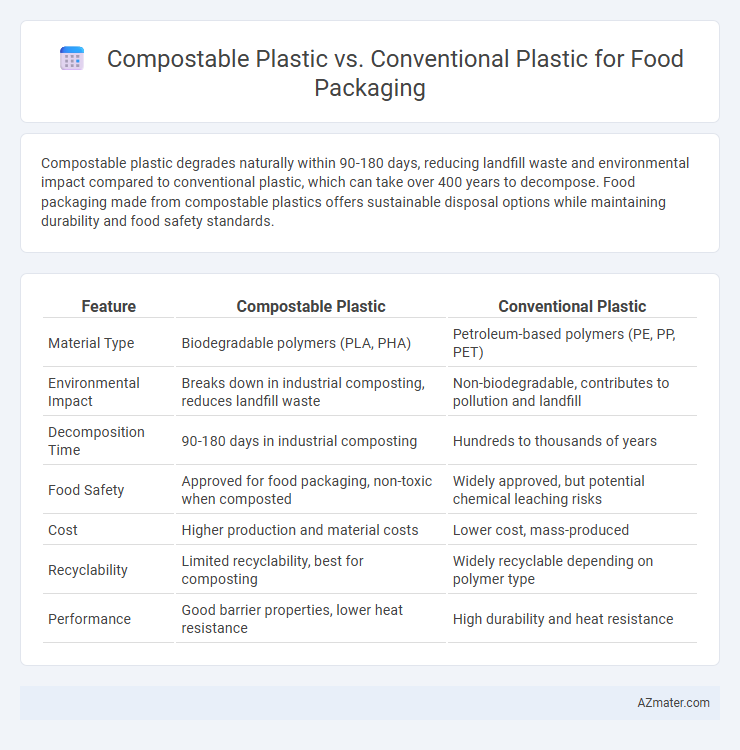Compostable plastic degrades naturally within 90-180 days, reducing landfill waste and environmental impact compared to conventional plastic, which can take over 400 years to decompose. Food packaging made from compostable plastics offers sustainable disposal options while maintaining durability and food safety standards.
Table of Comparison
| Feature | Compostable Plastic | Conventional Plastic |
|---|---|---|
| Material Type | Biodegradable polymers (PLA, PHA) | Petroleum-based polymers (PE, PP, PET) |
| Environmental Impact | Breaks down in industrial composting, reduces landfill waste | Non-biodegradable, contributes to pollution and landfill |
| Decomposition Time | 90-180 days in industrial composting | Hundreds to thousands of years |
| Food Safety | Approved for food packaging, non-toxic when composted | Widely approved, but potential chemical leaching risks |
| Cost | Higher production and material costs | Lower cost, mass-produced |
| Recyclability | Limited recyclability, best for composting | Widely recyclable depending on polymer type |
| Performance | Good barrier properties, lower heat resistance | High durability and heat resistance |
Introduction to Food Packaging Materials
Compostable plastics for food packaging are derived from renewable resources such as cornstarch and sugarcane, offering biodegradability within industrial composting facilities. Conventional plastics, typically made from petroleum-based polymers like polyethylene and polypropylene, provide high durability and moisture resistance but persist in the environment for hundreds of years. The choice between compostable and conventional plastics impacts sustainability, waste management practices, and regulatory compliance in the food packaging industry.
What Is Compostable Plastic?
Compostable plastic is a type of material designed to break down into natural elements within a compost environment, typically within 90 to 180 days, leaving no toxic residue. Unlike conventional plastic, which is petroleum-based and persists in the environment for hundreds of years, compostable plastics are made from renewable biomass sources such as corn starch or sugarcane, promoting sustainability in food packaging. This material meets specific standards like ASTM D6400 or EN 13432, ensuring it decomposes effectively and supports eco-friendly waste management.
Characteristics of Conventional Plastic
Conventional plastic used in food packaging is primarily derived from petrochemicals, offering high durability, flexibility, and moisture barrier properties that effectively preserve food freshness and extend shelf life. These plastics, such as polyethylene (PE) and polyethylene terephthalate (PET), exhibit excellent resistance to chemicals and temperature variations, making them suitable for diverse packaging needs. However, conventional plastics pose significant environmental challenges due to their non-biodegradable nature and contribution to long-term pollution in landfills and oceans.
Environmental Impact: Compostable vs Conventional Plastics
Compostable plastics used in food packaging significantly reduce environmental pollution by breaking down into natural elements within a few months under industrial composting conditions, unlike conventional plastics which persist for hundreds of years and contribute to landfill overflow and marine pollution. The production of compostable plastics typically relies on renewable resources such as corn starch or sugarcane, lowering carbon footprints compared to petroleum-based conventional plastics. However, the environmental benefit is contingent on proper disposal and composting infrastructure, as compostable plastics may not degrade effectively in standard landfill environments.
Biodegradability and Decomposition Rates
Compostable plastics for food packaging break down significantly faster than conventional plastics, typically decomposing within 90 to 180 days under industrial composting conditions. Conventional plastics can take hundreds of years to degrade, often persisting in the environment and contributing to plastic pollution. Enhanced biodegradability in compostable plastics reduces landfill volume and supports circular economy goals by transforming food packaging waste into valuable compost.
Food Safety and Shelf Life Considerations
Compostable plastics for food packaging offer enhanced environmental benefits but often have limitations in barrier properties compared to conventional plastics, potentially affecting shelf life and food safety by allowing higher moisture and oxygen transmission rates. Conventional plastics provide superior food protection through effective barriers against contamination and prolonged shelf life, critical for perishable items. Ensuring food safety with compostable plastics requires careful formulation and testing to meet standards for microbial resistance, while balancing biodegradability and functional performance.
Production and Resource Efficiency
Compostable plastics for food packaging are typically derived from renewable resources such as cornstarch or sugarcane, reducing reliance on fossil fuels used in conventional plastic production. The manufacturing process of compostable plastics often consumes less energy and emits fewer greenhouse gases compared to petroleum-based plastics, enhancing overall resource efficiency. However, conventional plastics benefit from well-established, high-throughput production systems that currently offer lower costs and higher scalability.
Cost Comparison for Manufacturers and Consumers
Compostable plastic food packaging typically incurs higher production costs than conventional plastic due to specialized materials and manufacturing processes, affecting manufacturers' pricing strategies. Consumers may face marginally increased prices for compostable options, driven by these production costs and emerging market demand. Over time, economies of scale and regulatory incentives could narrow the cost gap, making compostable plastics more competitive in price for both manufacturers and consumers.
Regulatory Standards and Certifications
Compostable plastics for food packaging must comply with standards such as ASTM D6400 and EN 13432, which ensure biodegradability and safe decomposition without toxic residues. Conventional plastics are primarily governed by food safety regulations like FDA and EFSA approvals, focusing on migration limits and chemical safety during use. Certifications like BPI, OK Compost, and Seedling logo validate compostability claims, while conventional plastics often lack specific sustainability certifications.
Future Trends in Sustainable Food Packaging
Compostable plastics for food packaging are gaining traction due to their biodegradability and reduced environmental impact compared to conventional plastics, which contribute significantly to landfill waste and ocean pollution. Innovations in bio-based polymers and enhanced composting infrastructure are driving the adoption of compostable packaging materials across the food industry. Future trends emphasize circular economy principles, with increased investment in recyclable and compostable food packaging solutions to meet stricter environmental regulations and consumer demand for sustainability.

Infographic: Compostable plastic vs Conventional plastic for Food packaging
 azmater.com
azmater.com